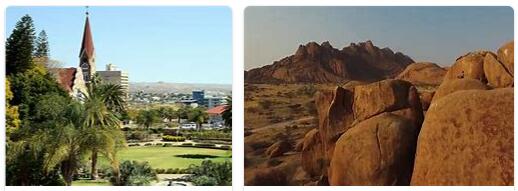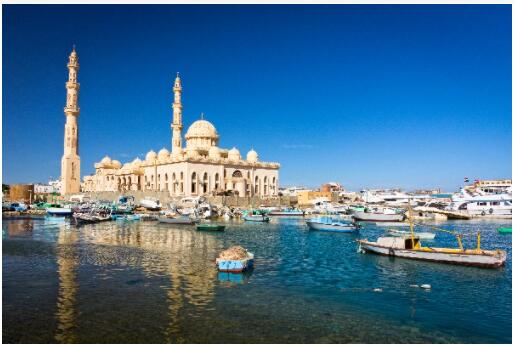Namibia Overview
(Republic of Namibia). State of Southwest Africa (824,116 km²). Capital: Windhoek. Administrative division: regions (13). Population: 2,364,433 (2012 estimate). Language: Afrikaans, English and German (official), Bantu, Herero, Nama, oshivambo. Religion: Protestants 51.4%, Catholics 16.5%, Anglicans 5.5%, other Christians 7.1%, others 19.5%. Currency unit: Namibian dollar (100 cents). Human Development Index: 0.624 (127th place). Borders: Angola (N), Zambia and Zimbabwe (NE), Botswana (E), South Africa (SE and S), Atlantic Ocean (W). Member of: Commonwealth, UN, SACU, SADC, UA and WTO, EU associate.
TERRITORY: HUMAN GEOGRAPHY
The population density is extremely low (3 residents/km², so much so that Namibia is among the least densely populated countries on the planet. From an ethnic point of view the population is very composite. The Bantu group includes about ten distinct tribes, among which are ovambo (ovambo, 34.4%), kavango (9.1%), bushmen and bergdama (7%), herero (5.5%), nama (4.4%) kwambi (3.7%) and other minor groups (27.8%). The white population (8.1%) is ethnically and linguistically distinguished in Afrikaaner, Anglophone community and a small community of German origin. The urban population, in 2012, was 39% of the total; except the capital Windhoek, the other main centers on the coast are Lüderitz, Swakopmund and Walvis Bay. The latter is the only port that allows the docking of large ships and monopolizes the country’s commercial traffic. Inland, some important centers are located along the communication routes and in the main mining areas (Grootfontein, Keetmanshoop and Otjiwarongo).
Environment
The marked aridity is affected by both the hydrographic network and the vegetation, which is mainly steppe, characterized by xerophilous plants, grasses, small trees such as acacias and euphorbias and thorny bushes. Savannas and some wooded areas appear only along the rivers and in the more irrigated north – eastern sector. The Namib desert, one of the oldest in the world, extends along the entire Atlantic coast and represents a region of great interest due to the presence of numerous plant and animal species, such as Welwitschia mirabilis, a plant whose leaves can be several meters long; oryx live here among the animals, elephants, small mammals, reptiles and some endemic species that over time have developed unique characteristics of adaptation to the arid climate. In the rest of the country the fauna is typical of tropical environments, with antelopes, tapirs, giraffes, zebras, lions and baboons. Drought is among the most urgent environmental problems that the country has to face, in addition to deforestation and soil erosion which also threaten protected areas (42.6%). Namibia has five national parks, among which the most important is the Etosha National Park, formed for over a quarter by the Etosha Pan, a saline depression of approx. 3600 km². The desert area bordering the sea (Namib Sand Area) was declared a UNESCO World Heritage Site in 2013. Visit ezinesports.com for Namibia travel package.
History
Already 27,000 to 5,000 BC. The first rock paintings of the San and Bergdama were created. In the 13th century the Herero and Ambo reached the coast of southern Africa. The Portuguese first visited the coast at the end of the 15th century, but it was not until the 18th century that whalers visited Walvis Bay. Probably in the 17th / 18th In the 19th century, Herero immigrated from the north. The 19th century was marked by conflicts between the Herero and the Nama, who lived in the south. In the process, the Orlam, who had been invading the Cape since 1800 and commanded by the white settlers ( Boers ) Weapons, military organization, language (Afrikaans) and partly Protestant Christianity had taken over, under the Nama the hegemony. Around 1830 the Orlam leader Jonker Afrikaner (* around 1790, † 1861) established his sovereignty over the south and the center of the country. In 1869/70 a new group of immigrants from the Cape, the Baster, founded their independent area around Rehoboth. In 1870 Protestant missionaries from Germany brokered a ten-year peace between Herero and Orlam.
On April 24, 1884, the German Empire declared the acquisitions of the Bremen merchant Franz Adolf Eduard Lüderitz around Angra Pequena (later Lüderitz Bay) to be the German protected area of German South West Africa and in 1885 extended the colonial ownership claim to all of Namibia. A treaty with Portugal established the northern border of the protected area on the Kunene in 1886. Great Britain and the German Empire agreed on the border to the British territories in 1890 in the Helgoland-Sansibar Treaty, which was also adopted by the incumbent Chancellor G. L. Caprivi named Caprivi-Zipfel came to German South West Africa. In 1893 the first white settlers settled in Windhoek. German rule was enforced against the local population by military force: uprisings of the Orlamführer H. Witbooi (1893/94), the Herero with parts of the Nama (January to August 1904; Battle of Waterberg), Witboois (October 1904) and others, Leaders, some of whom were not tied to any pre-colonial power, such as Jakob Morenga (fallen September 20, 1907), were suppressed. Tens of thousands of Herero and Nama were killed by 1908.
In 1908 the first diamonds were found near Lüderitz. In 1909 the German government granted the 9,400 German settlers limited self-government. During the First World War, troops of the South African Union (later the Republic of South Africa) conquered the German colony (surrender of the Schutztruppe at Otavi on July 9, 1915), which had to be ceded to the League of Nations in the Treaty of Versailles in 1919; this transferred the administration of the South African Union as a C mandate in 1920, d. H. as part of its own national territory, subject to a reporting obligation to the League of Nations (including guaranteed protection of the non-white population). The Republic of South Africa encouraged the settlement of whites alongside the remaining Germans, who became South African citizens with the right to vote in 1932.



